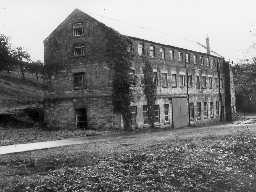Acklington Park ironworks and woollen mill (Acklington)
The ironworks building, was built in 1776 but converted to a blanket mill in 1791; working intermittently until the 1930s. (1)
Acklington Park Iron Works/Woollen Mill. Now converted (1980s) to luxury houses. Three storey building, ground floor presumed original with second and third storeys added later - lower two of stone, upper floor of brick. Water-powered tin and iron foundry designed by Smeaton for a group of speculators. By 1791 it was a woollen mill. Traces of the mill race and sluice gates. The mill continued in use into the 1930s as a dyer and bleachers. (2)
Speculators obtained a lease of land from the Duke of Northumberland in 1775 to build a foundry for manufacturing tin and iron. The dam (NU 20 SW 12) was built at this time. The distance from market led to the sale of the lease in 1791. The works were bought by John Reed, a woollen draper, and weavers were advertised for in 1796. The works were sold in 1828 to David Thompson, a Galashiels manufacturer, and the works remained in his family until 1884, when it was discontinued. (3)
The Dye House, grade II listed building. 1775, converted into flats 1968. In use until 1884; the building was taken over by Ellwood Holmes of Newcastle in 1915 to make hydrate of alumina. A Gilks water turbine in the mill race provided hydroelectric power - the mill was one of the first businesses in the country to be so lit. The factory closed in 1930 after pollution of the river and refusal of renewal of the lease. (4)
Guyzance, Brainshaugh Mill, NU 207 029. On River Coquet. Wheel powered. Derelict [in 1964-65]. Former blanket mill and part house. Noted by Major. (5)
Initially built in 1775 as a foundry for tin and iron, and converted to a woollen mill by John Reed in 1791, remaining in use as such until 1884; the derelict building was taken over by Ellwood Holmes of Newcastle in 1915 to make Hydrate of Alumina, a white pigment previously obtained from Germany. A Gilks water turbine in the millrace provided hydroelectric power, the mill being one of the first business premises thus lit in the country. The factory closed in 1930 after pollution of the river caused the Duke of Northumberland to refuse renewal of the lease. 1775, converted into flats 1968. Squared stone with roughly-tooled dressings (except for top floor, brick in Dutch bond). Welsh slate roof. 3 storeys, 14 windows. (6a)
Acklington Park Iron Works/Woollen Mill. Now converted (1980s) to luxury houses. Three storey building, ground floor presumed original with second and third storeys added later - lower two of stone, upper floor of brick. Water-powered tin and iron foundry designed by Smeaton for a group of speculators. By 1791 it was a woollen mill. Traces of the mill race and sluice gates. The mill continued in use into the 1930s as a dyer and bleachers. (2)
Speculators obtained a lease of land from the Duke of Northumberland in 1775 to build a foundry for manufacturing tin and iron. The dam (NU 20 SW 12) was built at this time. The distance from market led to the sale of the lease in 1791. The works were bought by John Reed, a woollen draper, and weavers were advertised for in 1796. The works were sold in 1828 to David Thompson, a Galashiels manufacturer, and the works remained in his family until 1884, when it was discontinued. (3)
The Dye House, grade II listed building. 1775, converted into flats 1968. In use until 1884; the building was taken over by Ellwood Holmes of Newcastle in 1915 to make hydrate of alumina. A Gilks water turbine in the mill race provided hydroelectric power - the mill was one of the first businesses in the country to be so lit. The factory closed in 1930 after pollution of the river and refusal of renewal of the lease. (4)
Guyzance, Brainshaugh Mill, NU 207 029. On River Coquet. Wheel powered. Derelict [in 1964-65]. Former blanket mill and part house. Noted by Major. (5)
Initially built in 1775 as a foundry for tin and iron, and converted to a woollen mill by John Reed in 1791, remaining in use as such until 1884; the derelict building was taken over by Ellwood Holmes of Newcastle in 1915 to make Hydrate of Alumina, a white pigment previously obtained from Germany. A Gilks water turbine in the millrace provided hydroelectric power, the mill being one of the first business premises thus lit in the country. The factory closed in 1930 after pollution of the river caused the Duke of Northumberland to refuse renewal of the lease. 1775, converted into flats 1968. Squared stone with roughly-tooled dressings (except for top floor, brick in Dutch bond). Welsh slate roof. 3 storeys, 14 windows. (6a)
N5580
Disclaimer -
Please note that this information has been compiled from a number of different sources. Durham County Council and Northumberland County Council can accept no responsibility for any inaccuracy contained therein. If you wish to use/copy any of the images, please ensure that you read the Copyright information provided.
